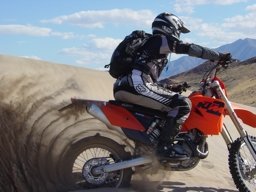Should I sit or…stand? What to do if you're new to motocross

A rider really can be the only to decide this. But of course, practice makes perfect.
Once you've found a personal comfort level in both standing and sitting positions, swapping between the two will almost be second nature. Though before you can leave your riding buddies in the dust, you might want to read on a little more.
Motorcycle setup and posture
First and foremost, your motorcycle needs to be set up so that it is comfortable to ride whether you’re standing or sitting. This usually involves a little adjusting. Typically, folks will need to move their gear shifter and rear brake lever up slightly and their clutch and front brake levers down slightly. Handlebars should be in line with the front forks and risers should not be considered unless the length from the foot pegs to the end of the handlebars is less than half the length of your height.
Many new off-road riders have trouble with unwanted throttle and steering input while standing. This is largely due to improper bike setup and can be solved by analysing your riding posture and controls. It is important to note that if you cannot comfortably use the controls, you will not feel comfortable standing and riding. It might take a little trial and error to find the adjustment that is right for you.
Sitting
For most people, sitting is the most natural position on the motorcycle. You save the most energy by sitting and have less distance to fall if you do crash. Typically, you sit when you are navigating long and relatively smooth sections or tighter corners on smooth terrain. Sliding back on the seat while sitting can help with acceleration, as well. Due to the increased weight over the rear tire, traction will be improved. When you think about sitting while riding off-road, think of flat-track racers and their ability to accelerate quickly and slide around corners.

Standing
Standing uses a bit more energy, but allows gives you more motion in balancing the motorcycle. Keeping your legs slightly bent will act like suspension as you cross obstacles in the trail, saving your back from injuries from the jarring. While standing, you will be able to quickly shift your weight forwards and backwards as needed to maintain traction for hills and obstacles, and side to side as needed for balance. Standing allows you to easily weight and de-weight (compressing and decompressing the suspension), a necessary technique for crossing larger obstacles.

Paddling
Paddling is done at slower speeds, through very technical or slippery terrain. It is important to note that paddling means to remain sitting on the seat of the bike and use your legs to dab on either side to remain upright. Paddling does not mean you are trying to push your way through with your legs. You should allow the motorcycle to do the work and only use your legs for balance – almost like training wheels. Most of the time when paddling you will want your bottom towards the rear of the bike to keep weight on the rear wheel for increased traction.
